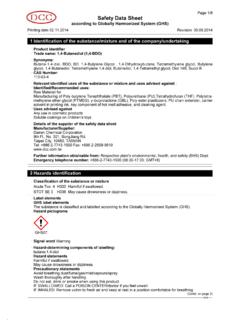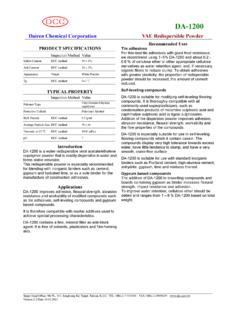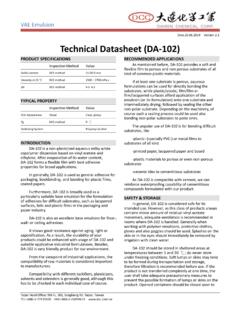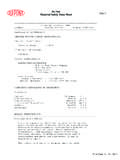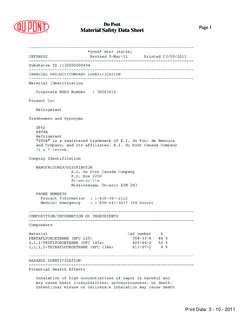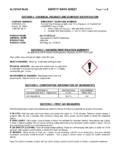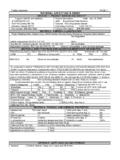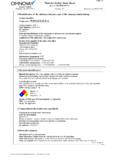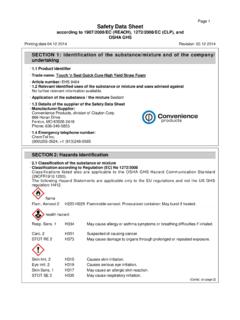Transcription of Page 1/7 Safety Data Sheet - dcc.com.tw
1 Page 1/7. Safety data Sheet according to Globally Harmonized System (GHS). Printing date Revision: 1 Identification of the substance/mixture and of the company/undertaking Product identifier Trade name: Vinyl Acetate-Ethylene Copolymer Emulsion (VAE). Applicable Models: DA-102. Synonyms: VAE emulsion, EVA emulsion, VAE dispersion, EVA dispersion, Ethylene-vinyl acetate copolymer emulsion, Vinyl acetate-ethylene copolymer dispersion, Ethylene-vinyl acetate copolymer dispersion CAS Number: The CAS No. of vinyl acetate-ethylene copolymer component is 24937-78-8, and is the same as ethylene- vinyl acetate copolymer.
2 Relevant identified uses of the substance or mixture and uses advised against : Identified/Recommended uses: Adhesive Sealant Building and construction preparations Details of the supplier of the Safety data Sheet Manufacturer/Supplier: Dairen Chemical Corporation 9th Fl., No. 301, SongJiang Rd. Taipei City, 10483, TAIWAN. Tel: +886-2-7743-1500 Fax: +886-2-2509-9619. Further information obtainable from: Respective plant's environmental, health, and Safety (EHS) Dept. Emergency telephone number: +886-2-7743-1500 (08:30-17:30; GMT+8). 2 Hazards identification Classification of the substance or mixture Skin Sens.
3 1 H317 May cause an allergic skin reaction. Label elements GHS label elements The product is classified and labelled according to the Globally Harmonised System (GHS). Hazard pictograms GHS07. Signal word Warning Hazard-determining components of labelling: 3(2H)-Isothiazolone, 5-chloro-2-methyl-, mixt. with 2-methyl-3(2H)-isothiazolone Hazard statements May cause an allergic skin reaction. Precautionary statements Wear protective gloves/protective clothing/eye protection/face protection. Contaminated work clothing should not be allowed out of the workplace. If skin irritation or rash occurs: Get medical advice/attention.
4 IF ON SKIN: Wash with plenty of water. Take off contaminated clothing and wash it before reuse. Dispose of contents/container in accordance with local/regional/national/international regulations. GHS. (Contd. on page 2). Page 2/7. Safety data Sheet according to Globally Harmonized System (GHS). Printing date Revision: Trade name: Vinyl Acetate-Ethylene Copolymer Emulsion (VAE). (Contd. of page 1). 3 Composition/information on ingredients Chemical characterisation: Mixtures Description: Mixture: consisting of the following components. Dangerous Components: 55965-84-9 3(2H)-Isothiazolone, 5-chloro-2-methyl-, mixt.
5 With 2-methyl-3(2H)-isothiazolone 0,0030%. Acute Tox. 3, H301; Acute Tox. 3, H311; Acute Tox. 3, H331; Skin Corr. 1B, H314; Aquatic Acute 1, H400; Aquatic Chronic 1, H410; Skin Sens. 1, H317. 108-05-4 vinyl acetate <0,5%. Flam. Liq. 2, H225; Carc. 2, H351; Acute Tox. 4, H332; STOT SE 3, H335; Acute Tox. 5, H303; Aquatic Chronic 3, H412. Non-Hazardous Component(s): Substance Name: CAS No: %. Vinyl acetate-ethylene 24937-78-8 55%. copolymer 4 First aid measures Description of first aid measures General information: First aider needs to protect himself. After inhalation: Supply fresh air; consult doctor in case of complaints.
6 After skin contact: Rinse cautiously with water for several minutes. After eye contact: Rinse opened eye for 15 minutes under running water. If symptom persists consult a doctor. After swallowing: Rinse out mouth and then drink plenty of water. Do not induce vomiting; call for medical help immediately. Most important symptoms and effects, both acute and delayed No further relevant information available. Indication of any immediate medical attention and special treatment needed Treatment of exposure should be directed at the control of symptoms and the clinical condition of the patient. 5 Firefighting measures Extinguishing media Suitable extinguishing agents: This product is non-flammable under normal circumstances.
7 Dried-up substance, however, is combustible. CO2, powder, foam, water, or water spray can be used to extinguish fire. Water jet can also be used in scenario of non-liquid combustion. For Safety reasons unsuitable extinguishing agents: None Special hazards arising from the substance or mixture Combustion of dried-up substance will release carbon oxides (CO, CO ). Advice for firefighters Use water spray to cool unopened containers. Protective equipment: If necessary, wear fully protective suit and air respirator. Additional information Avoid contact with skin, eye, and clothing. Do not inhale explosion gases or combustion gases.
8 GHS. (Contd. on page 3). Page 3/7. Safety data Sheet according to Globally Harmonized System (GHS). Printing date Revision: Trade name: Vinyl Acetate-Ethylene Copolymer Emulsion (VAE). (Contd. of page 2). 6 Accidental release measures Personal precautions, protective equipment and emergency procedures Wear protective equipment. Keep unprotected persons away. Ensure adequate ventilation Environmental precautions: Do not allow to enter sewers/ surface or ground water. Methods and material for containment and cleaning up: Collect, bind, and pump of spills. Absorb with liquid-binding material (sand, diatomite, acid binders, universal binders, sawdust).
9 Allow to solidify. Pick up mechanically. Reference to other sections See Section 7 for information on safe handling. See Section 8 for information on personal protection equipment. See Section 13 for disposal information. 7 Handling and storage Precautions for safe handling Wear protective gloves/protective clothing/eye protection/face protection. Ensure good ventilation/exhaustion at the workplace. Information about fire - and explosion protection: The product is not flammable. Storage: Requirements to be met by storerooms and receptacles: Store in cool, dry place in tightly closed receptacles.
10 Further information about storage conditions: Store at 5 C to 40 C. 8 Exposure controls/personal protection Additional information about design of technical facilities: Use local exhaust ventilation, or other engineering controls to maintain airborne levels below exposure limit requirements or guidelines. If there are no applicable exposure limit requirements or guidelines, general ventilation should be sufficient for most operations. Technical measures and appropriate working operations should be given priority over the use of personal protective equipment. Control parameters Ingredients with limit values that require monitoring at the workplace: The product does not contain any relevant quantities of materials with critical values that have to be monitored at the workplace.
